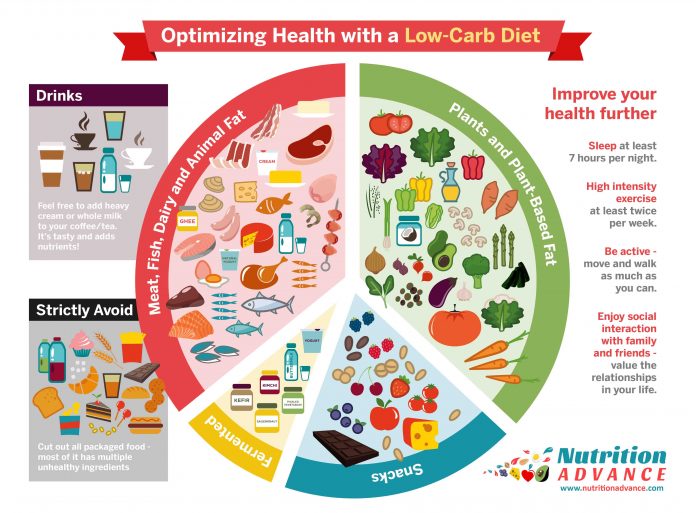INTRODUCTION
Low carbohydrate diets (Lowcarb) and specifically #keto have been really taking off as a mainstream nutrition plan. However, despite significant evidence it continues to get a bad rap. As with any “diet”, there are always good ways and bad ways to follow this plan.
So let’s take a look on how one defines lowcarb, the quality of the carbohydrate and who really could benefit from #lowcarb diets.
So, first let’s define “lowcarb.”

DEFINITION
These definitions are arbitrary but it becomes extremely important when you look at studies claiming to compare lowcarb to not highcarb. One definition comes from the Feinman et al. article.(1) But I’d like to modify it so it is easier to understand.
Very Low Carbohydrate (aka ketogenic or #keto). Less than 25-50 gm of carbohydrates
Low carbohydrate: 50-150 gm of carbohydrates
Everything else, to me, > 150gm to me is not really low carbohydrate, it is either moderate carbohydrate or high carbohydrate. The cut-off between moderate to high is not quite defined by number of grams of carbs, but more typically the % of calories. To me this can be quite confusing, and is not as simple to calculate. So, of a 2000 calorie diet, that means a 40% carbohydrate diet would account for 800 calories. Then dividing 800 by 4 calories per carb gram, yields 200 grams of carbs. Then for example, 45-65% of calories come from carbohydrates would net approx 225-325 gm of carbohydrates basing a 2000 calorie diet.
Confused yet? Yeah me too. Do we really have to be mathematicians to control our body weight? Not to get on a tangent, but if weight is really about calorie in=calorie out and the energy balance model, how does ANYONE maintain their weight prior to the invention of the calorie?
Ok, so as you can see, how we define lowcarb really makes a difference. So, when you read about lowcarb, moderate carb and high carb, take a look at how it’s defined to get a true sense if it’s “low carb.”
CARBOHYDRATE QUALITY
Prior to the obesity epidemic took off in the 1980’s, which coincides to the USDA sponsored Dietary Guidelines of America, we ate approximately 40% of our calories from carbohydrates. However, this is where I believe it’s the TYPE of carbohydrates that significantly accelerated the obesity epidemic — added sugar (sucrose) foods and refined carbohydrates –white, refined processed carbohydrates such as white rice, white bread, white pasta, and processed corn based products (chips) and packaged processed potato products (chips, fries). The fallacy becomes that all carbs are created equal and I argue that a sucrose carb is completely different that a broccoli carb.
WHO SHOULD CONSIDER #LOWCARB Lifestyle?
I believe that if most Americans cut out the processed white refined carbohydrates and minimizes any fried potato and all the added sugar in the diet, they will likely be on a low- to moderate carbohydrate diet, similar to pre-1980.
That being said, I do think there are people out there who can eat “highcarb” diet that is mainly real food, that is plant based and not processed junk that do well. A high carb vegetarian diet can be gummy bears, white pasta and a bunch of vegetables, but I don’t think that’s a balanced diet. So there are true fallacies about this low carb high carb business. But to me, if you have a cardiometabolic disorder that is likely due to to insulin resistance, you should do everything it takes to lower your insulin response to food.
And, the simplest method–a low carb diet. Wait, let me qualify this..a REAL FOOD low carb diet.
Also, Tim Noakes, recently published a great article reviewing the LCHF diet, and mentions 1. atherogenic dyslipidemia, 2. insulin resistance, and 3. Non-alcoholic fatty liver disease as prime targets for LCHF. (2)
A NEW PLATE?
Unfortunately, there hasn’t been a plate that I like that signifies what a lowcarb diet should look like. Probably because it should be individualized and I don’t think there’s a one plate fits all. However, this is the closest I think. (3)

http://nutritionadvance.com/benefits-low-carb-diet-guide-optimizing-health/
This is a great plate concept by Nutrition Advance. I don’t entirely agree with everything, but this is pretty good! Mainly vegetables, and meats/fish/dairy, and adds fermented foods and fruits and chocolate for snacks! I also like the HarvardPlate (4) except the whole grains may need to be limited in highly insulin resistant individuals or those who are going true kept. Also, the HarvardPlate promotes canola oil, which I think is debatable since it’s such a highly processed industrialized vegetable oil. Not so sure about this. I’d stick with the EVOO and other cold pressed oils.
Comments. What do you all think?
REFERENCES


